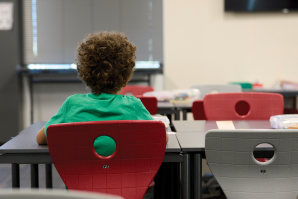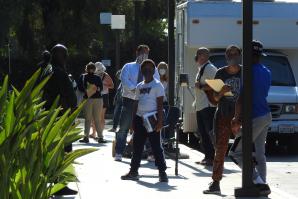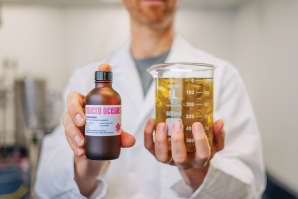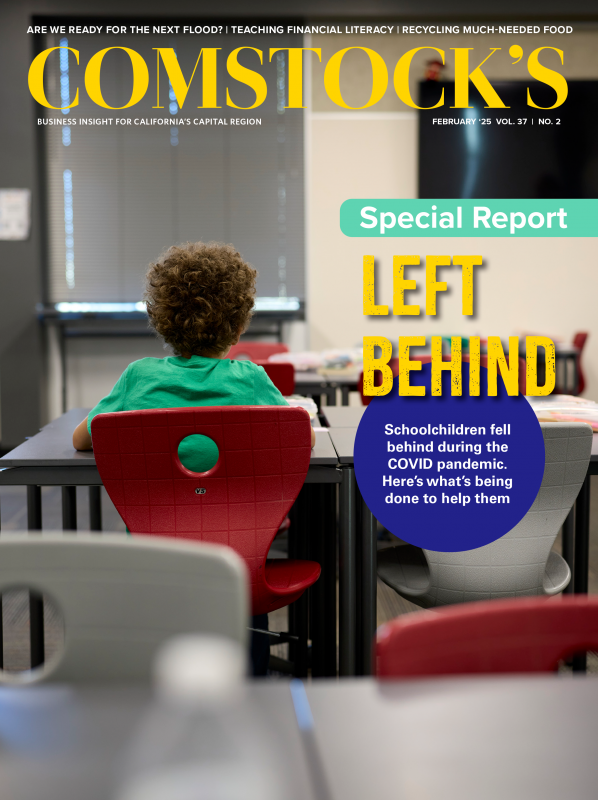A delivery truck plows through pools of water as it turns into a parking lot. The downpour is intensifying. The big rig’s exhaust mingles with a white winter fog before it gradually halts at Cordova Neighborhood Church. Two men in heavy jackets are soon braving the torrent to get its cargo box open. There is a lot inside. Looking on with an umbrella, Carrie Johnson can count seven wood pallets stacked with food and produce. It all came from a Costco about 3 miles away.
Johnson, executive director for Rancho Cordova Food Locker, can see the shipment includes a box of wholesome sandwiches and lettuce wraps pulled from the megastore’s deli this morning. Such tasty, non-expired bundles of lean protein and carbohydrates are essentially ready-made meals that her team can get into the hands of those who have nothing to cook with. For those with stoves and refrigerators, other items Johnson is inspecting might last for days.
This bounty has been going to food banks around the Capital Region since the implementation of SB 1383 — California’s groundbreaking organic waste collection bill aimed at reducing organic waste by increasing food recycling and composting.
This house of worship has been doubling as a food locker for 10 weeks now. Every morning at 6 a.m., a truck leaves its gates and heads out to eight grocery stores across Rancho Cordova. It’s on a constant foraging mission to help Johnson, her staff and a platoon of volunteers feed 1,200 families a week.
“I think the public’s perception is that it’s mostly the unhoused who are coming here,” Johnson reflects. “But of all the people we serve each week, only 2 percent are unhoused. The majority are working poor families, seniors and veterans. It’s wage loss. It’s job loss. It’s increased rents. It’s fixed incomes for seniors. For the seniors we serve, we’re their main source of getting protein and calories, because they have to make a decision between buying their prescriptions and buying food.”
On a Friday before Thanksgiving, Rancho Cordova’s food locker had 646 families — more than 1,200 people — come through its doors in a four-hour window. It was storming that morning, though residents still hurried through sheets of rain to get in. Johnson and her seven employees were lucky enough to have 100 volunteers bolstering them in that instance. No one panicked. Instead, everyone began cheerfully singing together.
Rancho’s food locker is one of 125 partner agencies of Sacramento Food Bank & Family Services. These organizations run the gamut of everything from neighborhood food pantries and school assistance programs to community meal sites and church soup kitchens. It’s a coalition that has been working with Sacramento County grocery stores on food recovery for some time. The implementation of SB 1383 has made the process more formalized and more bountiful.
“SB 1383 has allowed us to get more fresh food instead of just canned goods and staple pasta and rice,” Johnson says. “Now, we’ll get pallets of fresh produce — apples, pineapples, green beans, lettuce and tomatoes in the summertime. We get yogurt, milk and pre-made salads.”
She adds, “In the past, this is all food that otherwise would have been put in the garbage or into local dumps.”
The food recovery process for SB 1383 is divided into separate tiers. Tier 1, which involves large grocery chains and food distribution centers, went into effect in 2022. The following year, Rancho Cordova’s locker alone recovered 800,000 pounds of food. In that same period, Sacramento Food Bank & Family Services oversaw the redistribution of 14.6 million pounds of edible food that came directly from Capital Area grocery stores.
Food banks around the Capital Region have increased in need due
to the high cost of food. The Sacramento Food Bank coordinates
with 185 different grocery stores and retailers in our region to
get their unused food, says Communications Director Kevin
Buffalino.

“What came from those Tier 1 generators equates to about 38 percent of our food supply,” notes Kevin Buffalino, director of communications for Sacramento Food Bank. “It really is a large chunk of the food that we’re giving out to our neighbors in need.”
Statewide, the achievements have been eye-opening. CalRecycle recently announced on social media that in 2023, the state managed to divert 315 million unsold meals from landfills to people in need.
But now comes more uncharted waters: the implementation of SB 1383’s Tier 2. That involves getting meals and items from restaurants, catering companies, hospital cafeterias and hotels. Food recovery specialists stress that Tier 2 is far trickier territory than working with grocery stores. Restaurant owners, in particular, have a lot of concerns — and a lot at stake — if something goes wrong with this part of the law that went into effect in 2024.
A growing need
SB 1383 has been marked by a long path to implementation. It was authored in 2016 by then-State Senator Ricardo Lara from Long Beach (California’s current insurance commissioner). What Lara called “the Super Pollutant Reduction Act” was signed by Gov. Jerry Brown later that year. The idea was straightforward — reduce greenhouse emissions from organic waste in landfills by steering appropriate leftover food to hunger programs and the rest to composting or animal feed. It was a moment when Brown was promoting California as a green leader on the world stage. However, by the time Tier 1 was actually going into effect, a whole different conversation about California was in the news: The Census Bureau had released data identifying the Golden State as having the highest poverty rate in the nation.
It’s that pall that hangs over Sacramento County’s food banks and continues to make Tier 1 of the SB 1383 so relevant.
Sacramento Food Bank has a full-time staff member coordinating with 185 different grocery stores and food retailers around the Capital to make the initiative go smoothly. In some cases, those working relationships have already been built over years. Other stores are newer to the fold.
“Our staff member meets with the retailers and makes sure that they’re not only aware of the law, but also educates them on food safety handling and what they can donate and why it’s so important,” Buffalino explains. “Prior to SB 1383, the food bank was already collecting food from about 95 percent of retailers in Sacramento County. Now, with the law ensuring that everything is compliant, we’re now at 100 percent.”
A working group of local governments in Sacramento County have contracted with Abound Food Care to help implement SB 1383. Based in Orange County, Abound has 14 years of experience in addressing food recovery challenges around California, including the most sensitive ones that accompany dealing with restaurants.
Abound’s CEO Mike Learakos says one task his organization has in Sacramento is coordinating with CalRecycle, California Resource Recovery Association and other agencies on building a data-driven picture of what’s happening with the new law.
“We need to know things like, what amount of food is being recovered? Where is this food going? How much of it is feeding people, and how much of it goes to other forms of diversion like anaerobic digestion, composting or animal feed? And how much is still going to the landfill?”
Learakos explains. “The data analytics on this are going to be critical for getting a return on our investment, especially if our goal is to have an environmental benefit. That means we have to look at how many passenger vehicles are being used to recover food and how much fuel we’re turning as we try to pick up food that may or may not be feeding someone.”
Abound Food Care is also the proverbial tip of the spear for making Tier 2 work for restaurants in Sacramento.
The next challenges begin
The Capital city’s culinary world is nervous about what happens next. A restaurant’s identity and notoriety are paramount, especially given that its business model survives on famously thin profit margins. A number of owners have expressed concern about extra food being taken directly from their kitchens, then brought to places they don’t know, then stored in ways they can’t see, and then re-distributed on timelines they don’t control — all while still being associated with their restaurant’s brand and banner.
Carrie Johnson, executive director for the Rancho Cordova Food
Locker, stands besides fresh fruits and vegetables that will go
out to community members in need.

If the food is mishandled at any point along the way, and someone gets sick because of it, state and federal law will shield that restaurant from legal liability. However, it won’t protect them from reputational harm with their potential customer base.
In an era of Yelp, Tripadvisor, Google Reviews and an array of social media platforms, it feels like a significant risk. At least, that’s some of the feedback that has been coming to Abound as they plot a course forward. Lisa Coelho is Abound’s program manager for Sacramento County. She’s spent months now working with everyone from stakeholders in the private sector to the county’s public health department to address such worries. Coelho says the best way to describe Sacramento’s current status with Tier 2 is calibrating a workable action plan with genuine consensus.
“We need to set a foundation before we pump a lot of food into the system,” Coelho cautions. “We want to make sure it is going to be safely packaged, safely labeled, cooled down correctly and sent to an organization that has the right permits to handle it. We need to have really clear messaging when we come into a restaurant beyond just, ‘Please donate.’”
In certain cases, the food lockers have their own trepidation about accepting donations that come via Tier 2. Coelho notes that this is particularly true of accepting seafood from a restaurant. Those dishes have even higher levels of safety protocols for handling and storage. Such concerns are why Abound is constantly communicating with state and county officials.
Dr. Olivia Kasirye, public health officer for Sacramento County,
believes the effort to navigate these issues must be a collective
one.
“This was a huge undertaking for our department, in terms of
learning about the food systems,” Kasirye says. “Many of these
community-based organizations have not had to work with the
county before, so having Abound Food Care available to build
those bridges and work with them is really important. With Tier
2, there are a lot of challenges ahead, but I think we have a
good team. It’s very important we do this together.”
Another challenge associated with both tiers of SB 1383 involves staff capacity and logistical expenses at local food banks. CalRecycle has launched a $130.6 million grant program to help local jurisdictions implement SB 1383. While that’s been a big factor in all the success stats of late, smaller food lockers still have to bear much of the food recovery costs by tapping their own budgets. That means neighborhood meal programs need more donations and volunteer support than ever. And it’s not just the law they are grappling with. It’s the demand.
“We saw food recovery organizations grow very rapidly during COVID — overnight doing whatever they could to take in more food, and serve more clients; and pretty much everyone believed that was temporary and there would be a day when we went back to normal,” Coelho remembers. “But we work with organizations across the state, and that just hasn’t happened.”
Stay up to date on business in the Capital Region: Subscribe to the Comstock’s newsletter today.
Recommended For You

California Students Are Now Required to Take a Money Course; Some Are Already Taking It to Great Success
Despite polls showing overwhelming public support for teaching financial literacy skills to school students, prior to the passage of McCarty’s bill California had no statewide requirements around financial literacy courses in the schools. As a result, the infrastructure that does exist around this has largely been developed through the initiatives of a few banks and some forward-looking schools.

Is Sacramento Ready for the Big One?
Levees and dams are being repaired and expanded to prepare for a future flood
Climate change is increasing the strength of Sacramento’s winter storms. Higher temperatures allow atmospheric rivers to carry more water, research shows. Climate change is also jacking up other flood risks, such as sea rise and snowmelt. All this is raising the chances of catastrophic flooding in Sacramento.

Drought and Deluge
Experts are racing to protect the Central Valley from a catastrophic flood
Unlike “The Big One” earthquake that is overdue along the San Andreas Fault, experts don’t have an ominous name for a flood of biblical proportions that is likely to inundate the Central Valley within the next 500 years.

Sacramento-Area Schools are Still Grappling With Academic and Social Recovery From the COVID-19 Pandemic
Around the Capital Region, schools are still working to recover socially and academically from the COVID-19 pandemic. Test scores have been affected, as has school attendance. A new wave of behavioral issues has unfolded, too. Now, a variety of people are working to help students catch up.

What the State Is Doing to Help Education
Efforts by California’s government to help students recover from the pandemic go back to its earliest days, with the state investing more than $36 billion to deal with pandemic impacts. The funding has gone to Learning Recovery Emergency Block Grants, expanded teacher recruitment, literacy specialists and much more.

The Pandemic Made Many Parents Get More Involved in Their Children’s Education
“I think what the pandemic really did was just lift the curtain on what was taking place in the classroom and at the administration level for parents to see,” says Justin Caporusso, a Roseville father of four and owner of Caporusso Communications. “A lot of parents saw how much time was spent on classroom management, behavior and really how little time was spent on kind of overall education.”

New Year, New Administration. What Can We Expect?
The Capital Region’s economy in the first half of 2025 should be unspectacular but steady, forecasters say
The apocalyptic tenor of the recent election made it seem disaster was inevitable no matter who won. But at least on the economy, the first half of 2025 should be a sigh of relief, letting most businesses stick to small ball.

Architects Respond to the Growing Population of Minority, Immigrant and Refugee Students With Culturally Sensitive Design
The influx of immigrants and refugees from a multitude of different countries has created an opportunity and a challenge for Capital Region architects to design educational spaces with greater cultural sensitivity that provide a sense of belonging for new students and families.

What’s on the Horizon for California’s Public Lands?
With less funding in the current budget, the management of public lands is likely to change substantially, and this may have massive and unforeseen consequences for Californians.

The Power and Potential of Seaweed
From keeping oceans healthy to being used as an alternative to plastics, researchers believe seaweed has a multitude of uses
Nearly 2,000 miles northwest of Sacramento, Matthew Perkins rode a boat out into the Gulf of Alaska and saw nothing but endless potential for growth. “It’s kind of overwhelming how much opportunity there is,” he says. “You’re on the water, snow-capped mountains in the backdrop, you look down and see this incredible biomass growing. It’s literally the bounty of nature.”




